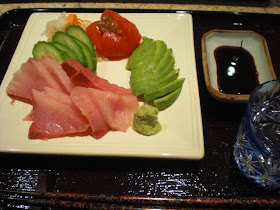Here is the hamachi sashimi I served with a "sashimi" avocado, Campari tomato with moromi miso もろみみそ and quickly made daikon namasu 大根なます(daikon in sweet vinegar). Wasabi is, as usual, real wasabi from the tube but this time, I had to perform a surgery (C-section) and take out the wasabi from the tube and mix the liquid and solid together to reconstitute (This is one of the problems of real wasabi in a tube--the water gets squeezed out but not the solids). It does have a nice smell and flavor very close to real grated wasabi rhizome, though.
Some times, Catalina does carry fresh hamachi but we have not tried it yet. This one was from Kyushu 九州, farm raised and flash frozen in minus 50C judging from what the package stated. It was treated with carbon monoxide (like a frozen tuna sashimi block) for retention of the color (it does not change the taste, is not preservative and is not harmful to your health). This package was rather large (long) and I had to soak it for several hours in the kitchen sink filled with cold water reinforced with ice cubes to thaw it. (They recommend using ice water rather than running water because, I suppose, the running water thaws the fish too quickly and unevenly). After it is thawed and out of the package the sashimi block looks like seen on the right below.
Some times, Catalina does carry fresh hamachi but we have not tried it yet. This one was from Kyushu 九州, farm raised and flash frozen in minus 50C judging from what the package stated. It was treated with carbon monoxide (like a frozen tuna sashimi block) for retention of the color (it does not change the taste, is not preservative and is not harmful to your health). This package was rather large (long) and I had to soak it for several hours in the kitchen sink filled with cold water reinforced with ice cubes to thaw it. (They recommend using ice water rather than running water because, I suppose, the running water thaws the fish too quickly and unevenly). After it is thawed and out of the package the sashimi block looks like seen on the right below.


No comments:
Post a Comment
When you post a comment on the post, it does not appear immediately pending moderation.